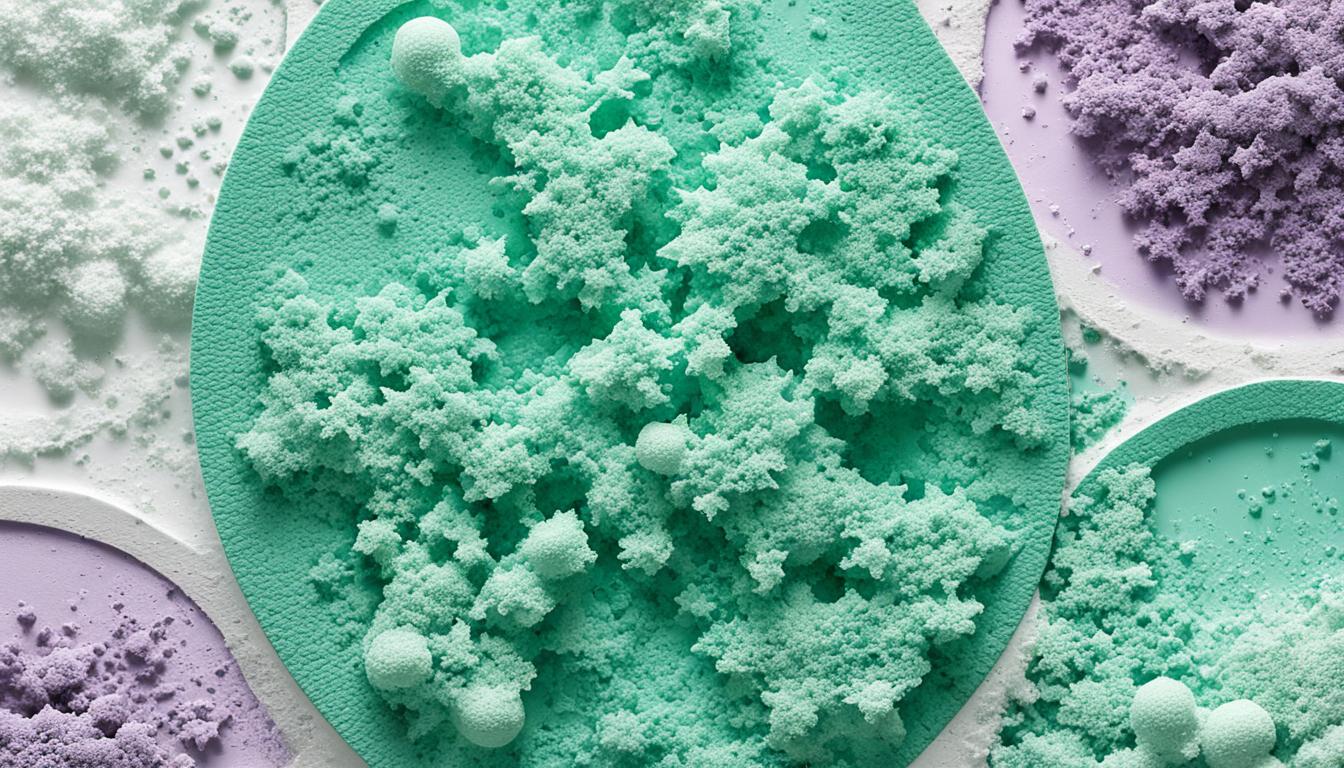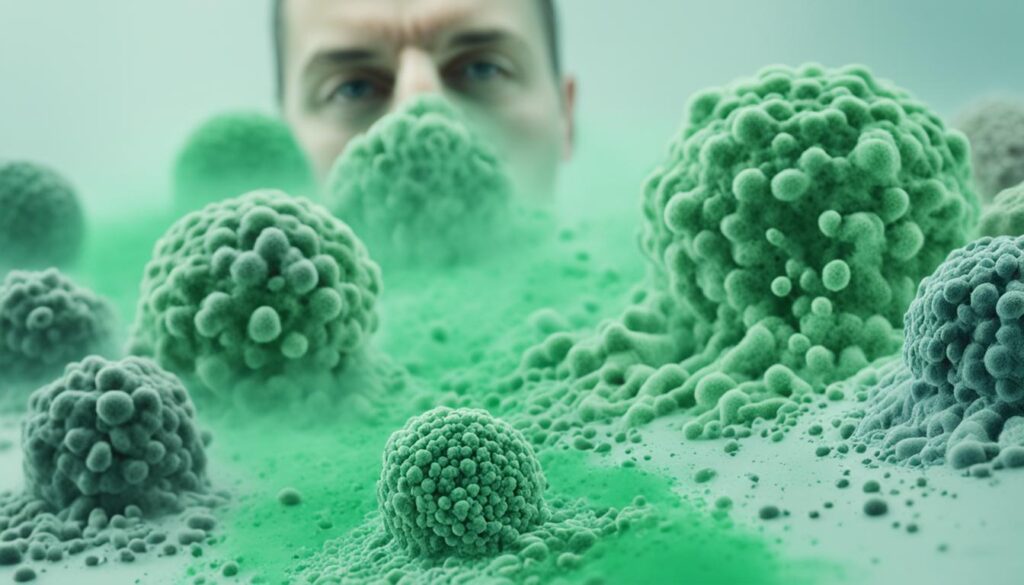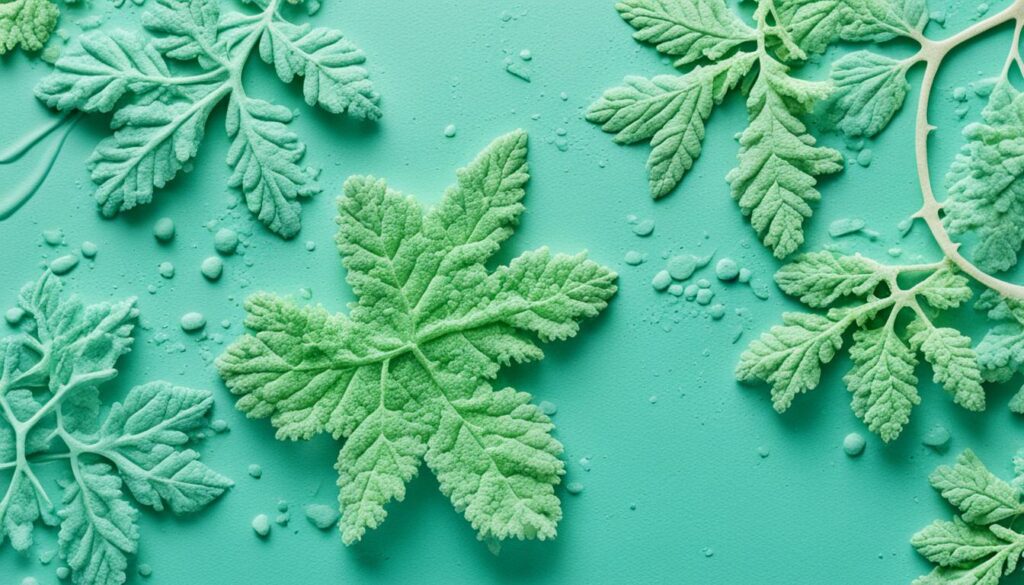
Less Hazardous Mold Colors for Human Health
In this section, we will explore the different colors of mold and their varying levels of danger to human health. Understanding the potential health risks associated with different mold colors is crucial for maintaining a safe and healthy environment.
The Different Colors of Mold and Their Meanings
Mold can come in various colors, each representing a specific type of mold and potentially indicating varying levels of toxicity to humans. Understanding the different colors of mold and their meanings is essential for identifying potential health risks and taking appropriate measures for assessment and prevention.
Below, we provide an overview of some common mold colors and their corresponding meanings:
Green Mold: Green mold is one of the most common types of mold and is often found on surfaces with high moisture levels. While not all green mold is toxic, some variations like Aspergillus or Penicillium can pose risks to human health.
Black Mold: Black mold, scientifically known as Stachybotrys chartarum, is infamous for its potential health hazards. Prolonged exposure to black mold spores can lead to respiratory issues, allergies, and even severe illnesses.
Yellow Mold: Yellow mold is often a characteristic of Aspergillus mold. While it may not be as toxic as black mold, prolonged exposure to yellow mold can still cause allergic reactions, respiratory problems, and skin irritation.
White Mold: White mold is commonly found in humid environments and can grow on various organic materials. While not all white mold is harmful, some species like Sclerotinia sclerotiorum can induce respiratory issues and allergic reactions.
Brown Mold: Brown mold, such as Alternaria or Cladosporium, often thrives in damp areas. It can cause respiratory problems, especially in individuals with pre-existing respiratory conditions or weakened immune systems.
It’s important to note that the color of mold isn’t always a definitive indicator of its toxicity. In some cases, mold may appear in different colors depending on the stage of its growth or the presence of contaminants.
Furthermore, mold can also appear in shades of blue, gray, orange, and even pink, each with its own set of potential health risks.
To effectively address mold issues, it’s crucial to consult professionals for proper identification, assessment, and remediation. Taking proactive measures to prevent mold growth, such as controlling moisture levels and improving ventilation, can also help maintain a healthy living environment.
| Mold Color | Common Types | Health Risks |
|---|---|---|
| Green | Aspergillus, Penicillium | Respiratory issues, allergies |
| Black | Stachybotrys chartarum | Severe respiratory issues, allergies, infections |
| Yellow | Aspergillus | Allergies, respiratory problems, skin irritation |
| White | Sclerotinia sclerotiorum, others | Respiratory issues, allergies |
| Brown | Alternaria, Cladosporium | Respiratory problems, allergies |
Less Dangerous Mold Colors
In this section, we will explore the mold colors that are generally considered to be less dangerous to human health. Understanding these safe mold colors is important for maintaining a healthy environment and minimizing health risks.
While all molds have the potential to cause health issues, certain colors indicate a lower level of toxicity compared to others. Here are some mold colors that are typically associated with less hazardous molds:
- White: White mold is often considered less dangerous as it is commonly found on non-organic materials, such as bathroom tiles or cabinets. However, it should still be addressed promptly to prevent further mold growth.
- Gray: Gray mold, also known as Cladosporium, is one of the most common types of mold. While it can cause allergies and respiratory issues in some individuals, it is generally less hazardous compared to other mold colors.
- Light Green: Light green molds, like Penicillium, are often found on fruits, bread, and other organic substances. These molds are typically less dangerous to health but can still trigger allergic reactions in sensitive individuals.
- Light Blue: Light blue molds, such as Aspergillus versicolor, are commonly found in water-damaged areas. While they can cause health issues, they are considered less hazardous compared to darker colored molds.
It is important to note that the color of mold alone is not a definitive indicator of its toxicity. Professional mold testing and assessment should be carried out to accurately identify the specific type of mold and its potential health risks.
“Understanding the characteristics and potential health risks associated with different mold colors is crucial for creating a safe and healthy living environment.”
To help visualize the different mold colors, here is an informative table:
| Mold Color | Description | Potential Health Risks |
|---|---|---|
| White | Commonly found on non-organic materials, such as bathroom tiles or cabinets. | Potential allergenic reactions; can exacerbate respiratory conditions. |
| Gray | One of the most common types of mold; often found in indoor spaces. | Potential allergenic reactions; respiratory issues in some individuals. |
| Light Green | Found on fruits, bread, and other organic substances. | Potential allergenic reactions; can cause respiratory issues in sensitive individuals. |
| Light Blue | Commonly found in water-damaged areas. | Potential allergenic reactions; respiratory issues in some individuals. |
It’s important to address any mold growth, regardless of color, as soon as it is discovered. Proper remediation techniques should be employed to safely remove and prevent the spread of mold, ensuring a healthier living space.
Stay tuned for the next section where we will discuss the health risks and effects of mold exposure.
Health Risks and Effects of Mold Exposure
Exposure to mold can have significant implications for human health, leading to a range of health risks and effects. It is essential to understand the potential consequences of mold exposure to take appropriate measures for assessment, prevention, and remediation.
Common Symptoms of Mold Exposure
Mold exposure can manifest in various symptoms, both mild and severe. Some of the most common symptoms include:
- Coughing and sneezing
- Respiratory issues
- Nasal congestion
- Watery or itchy eyes
- Skin irritation or rashes
- Headaches or migraines
- Fatigue and weakness
Potential Long-Term Health Consequences
Long-term exposure to mold can lead to more severe health consequences, particularly for individuals with weakened immune systems or pre-existing respiratory conditions. Some potential long-term health effects of mold exposure include:
- Chronic respiratory infections
- Asthma development or worsening of existing asthma
- Allergic reactions
- Chronic sinusitis
- Neurological symptoms
- Immune system suppression
Mold toxicity can vary depending on the type and amount of mold present, as well as an individual’s susceptibility. Therefore, it is crucial to address mold issues promptly and effectively to mitigate the potential health risks.
“Mold exposure can have detrimental effects on human health, ranging from common respiratory symptoms to severe long-term consequences. It is crucial to prioritize mold assessment, prevention, and remediation to safeguard the well-being of individuals.”
| Health Risks and Effects of Mold Exposure | Severity |
|---|---|
| Respiratory issues | Mild to Severe |
| Allergic reactions | Mild to Moderate |
| Asthma development or worsening | Moderate to Severe |
| Chronic sinusitis | Moderate |
| Neurological symptoms | Mild to Severe |
| Immune system suppression | Moderate to Severe |
Understanding the Impact of Mold Colors on Health
When it comes to mold, it’s not just about the presence of spores that can cause health issues; the color of the mold can also play a significant role in potential health risks. Different mold colors can indicate varying levels of toxicity and impact human health in different ways. In this section, we will delve into the potential health hazards associated with specific mold colors and why some colors may pose higher risks than others.
One of the most common mold colors is black. While black mold, scientifically known as Stachybotrys chartarum, is often associated with severe health problems, it’s important to note that not all black-colored molds are highly toxic. However, black mold can produce mycotoxins, which, when inhaled or ingested, can lead to respiratory symptoms, allergic reactions, and even neurological issues in some individuals.
Another mold color to be aware of is green. Green mold, such as Aspergillus and Penicillium, is commonly found in damp environments, including bathrooms or areas with water damage. While some strains of green mold may not be as hazardous as black mold, prolonged exposure can still cause respiratory problems, allergic reactions, and potentially aggravate existing health conditions.
Yellow or orange-colored molds, like Aureobasidium, can also pose health risks. These molds are commonly found in areas with high humidity or water leaks. Exposure to these molds can lead to allergic reactions, skin irritation, and respiratory issues.
White or gray-colored molds, such as Cladosporium and Fusarium, are also commonly found indoors. While they may not be as visually striking as black or green molds, they can still have adverse health effects. These molds can cause respiratory symptoms, eye irritation, and skin rashes when exposed for extended periods.
It’s important to remember that the impact of mold colors on health can vary depending on individual sensitivity, duration of exposure, and overall health status. If you notice any mold growth in your environment, regardless of its color, it’s best to take immediate action and consult with professionals for proper assessment and remediation.

Proper identification of mold colors and understanding their potential health hazards is crucial for creating a safe and healthy living environment. By being aware of the risks associated with specific mold colors, individuals can take proactive measures to prevent and address mold growth effectively.
Best Mold Colors for Health
When it comes to mold growth in your environment, choosing the right colors can be crucial for maintaining the health and safety of you and your loved ones. Certain mold colors are considered to have lower health risks, making them the best options for your home or workplace. In this section, we will discuss the best mold colors for health, providing valuable insights and guidance for mold assessment and prevention.
Mold Colors with Lower Health Risks
1. Green:
A common mold color, green mold is generally considered to have lower health risks compared to other colors. However, it’s important to note that not all green molds are safe, as some can still pose health hazards. If you notice green mold in your environment, it is recommended to consult with a professional mold removal service to assess its potential risks and take appropriate measures.
2. White:
White mold is often considered less dangerous and may have lower health risks. However, it is essential to address white mold promptly to prevent further growth and potential health issues. If you discover white mold in your home or workplace, it is advisable to seek professional assistance to ensure proper evaluation and remediation.
3. Gray:
Gray mold is another color that typically has lower health risks. However, as with any mold color, it is vital to address the underlying causes and properly remove the mold to prevent its spread and potential health hazards. Professional mold assessment and remediation services can help identify and mitigate gray mold effectively.
Preventing Mold Growth
While certain mold colors may have lower health risks, prevention is always the best approach. Here are some preventive measures you can take to minimize mold growth:
- Keep indoor humidity levels below 50% to prevent mold growth.
- Properly ventilate damp areas, such as bathrooms, kitchens, and basements.
- Fix any leaks or water damage promptly.
- Regularly clean and inspect areas prone to moisture buildup, such as air conditioning units and ducts.
- Ensure proper insulation to prevent condensation.
Remember, if you suspect or notice any mold growth in your environment, it is crucial to consult with professionals who can assess the situation and provide appropriate remediation measures.
Now that you are aware of the best mold colors for health and effective preventive measures, you can make informed decisions to create a safe and healthy living or working environment for yourself and those around you.
| Mold Color | Health Risk Level |
|---|---|
| Green | Low |
| White | Low |
| Gray | Low |

Conclusion
In conclusion, it is crucial to understand the varying health risks associated with different mold colors in order to maintain a safe and healthy environment. By being able to identify less dangerous mold colors, individuals can take appropriate measures for assessment and prevention, effectively mitigating the potential health hazards posed by mold.
When dealing with mold, it is essential to prioritize the safety and well-being of oneself and others. By staying informed and aware of the potential health risks associated with different mold colors, individuals can take proactive steps to prevent mold growth and minimize exposure.
If you suspect mold in your home or workplace, it is advisable to seek professional assessment and remediation services. Fix Mold Miami, with their expertise and experience, can provide comprehensive mold assessments and reliable mold remediation in Miami. You can reach out to them at 305-465-6653 for assistance in securing a safe and mold-free environment.




